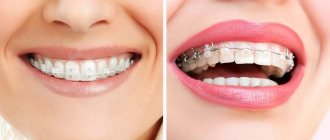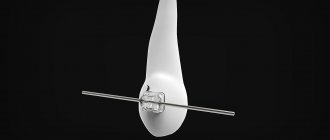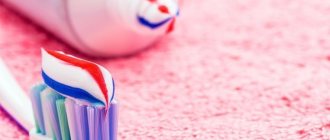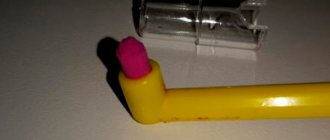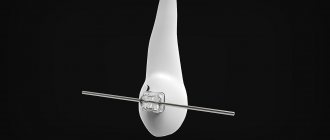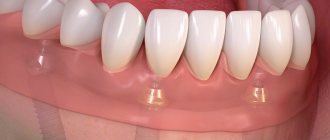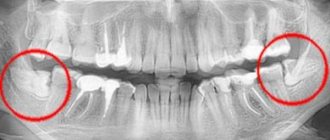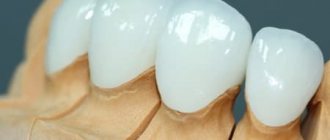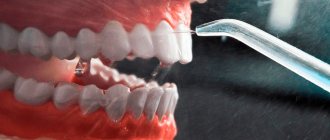Many people dream of a gorgeous smile. But not everyone gets it from birth. You have to put in a lot of effort to achieve the desired result. A smile helps a person make contacts in society, even build a career.
One of the methods of obtaining a correct bite is correction with braces. Even though this is a slow method, the end result lasts a lifetime.
There are situations in medical practice when braces cannot fully realize what they want on their own. In such cases, orthodontists resort to the use of additional means. For complex malocclusion defects, traction for braces or, as they are also called, elastic bands are used. Installing elastic bands on braces is the next step in wearing braces, after the patient gets used to wearing them.
When to use traction for braces
Elastics for braces are durable rings of different sizes made of hypoallergenic material (rubber). Elastic bands are an elastic force component that strengthens the brace system. They control the symmetrical arrangement of the jaws, as well as the alignment of the teeth in relation to each other.
Orthodontists identify the following main functions of elastic bands:
- ensure reliable fastening of the arcs to the plate;
- enhance the effect of the structure;
- as an auxiliary corrective action for defective bite;
- reduce the time for correcting the position of the jaws.
Examples of application on braces:
- Presence of “ungrown” teeth. It happens that one tooth does not erupt due to lack of space in the dentition. Then a button is attached to this tooth, onto which the elastic is placed. The elastic pulls the missing tooth into a row.
- Broken bite. It is rubber rods that correct malocclusion.
- Presence of cracks.
Elastic bands for braces. Why are they needed and how to wear them correctly
Unfortunately, not everyone can boast of a Hollywood smile. But today, orthodontists have learned to effectively cope with the problem of crooked teeth and malocclusion, and correction is possible at any age. For this purpose, safe orthodontic structures – braces – are used.
To obtain the highest possible treatment result when wearing a corrective system, it is advisable to use additional devices along with it. We are talking about rubber bands for braces. What these elastic bands (otherwise called pull-ups) are, as well as what benefits they provide, will be discussed in this article.
A defective bite is not only a cosmetic problem. Pathology poses a threat to the condition of the teeth, jaw system, digestive system and the body as a whole:
- Irrational load on the dentition leads to premature wear of the teeth, which are subject to double pressure.
- Poor quality grinding of food in the oral cavity causes diseases of the stomach and other parts of the digestive canal.
- Doctors have long paid attention to the relationship between frequent headaches and malocclusion.
Taking into account the harm that a dental disorder causes to the human body, it is not difficult to guess that care should be taken to eliminate such a pathology as early as possible.
Design features of braces
Not so long ago, correcting a malocclusion was almost impossible. Doctors did not treat such a pathology as “abnormal dental condition” in adults at all. The situation has changed dramatically with the advent of high-quality braces.
The latter are unique orthodontic structures, unique mechanisms. By influencing the dental rows, they gradually align them. Such systems are intended to correct two large groups of bite pathologies:
- aesthetic dental anomalies (cosmetic imperfections);
- functional anomalies, when there is a risk of medical troubles and complications.
The device consists of parts - braces. Each particle affects the tooth to which it is attached, changes its position, and aligns it. All plates are fastened together with wires and thin springs. A bow is attached to them, to which the doctor gives a physiological bend. Over time, the arch forms the correct bite.
Specifics of fastening close
A single brace alone will not change the situation. The result is achieved by the coordinated interaction of all structural elements:
- plates (braces);
- spring;
- temples;
- elastic bands.
Braces are made from a special material that “memorizes” its shape. The arches are initially shaped into a perfectly correct bite. The structure installed on the jaw tries to return to its original position, thereby “stretching” the dental row. Thus, the dental defect is eliminated after some time.
The patient has to wear the complex multi-component mechanism fixed on the jaws for quite a long time, because the therapeutic course consists of several time-consuming stages.
During such treatment, especially at its initial stage (adaptation), the patient may experience a feeling of discomfort and excessive pressure from the brace system - after all, the structure is a foreign object for the oral cavity and the body needs to get used to it.
Orthodontic elastic bands
The main task of braces is to regulate jaw movements and return teeth to their normal position. To make the process more successful and faster, special elastic bands (so-called traction bands) are used that are attached to the braces. They are elastic rings of different parameters. They are made from stretchy, but at the same time quite durable material.
There are different variations of how rubber bands are attached to the system. The method must be chosen by the doctor, taking into account the type of pathology and the nature of the expected result. The doctor attaches elastic bands to the installed structure, due to which:
- ensures reliable grip of the jaws;
- additional pressure is placed on the dentition that needs to be corrected;
- the effect of the plates is enhanced.
The elastic bands are fixed in a certain place in the structure. When installed correctly, a moderately tight bond is obtained. It is important to maintain uniform tension on both sides.
Wearing rules for patients
While wearing an orthodontic structure, patients are prohibited from eating solid foods (nuts, crackers, hard fruits, etc.). This leads to wear and damage to the rubber bands.
The elastics are permanently attached to the structure and can be removed while brushing your teeth. Metal braces or ceramic - it doesn't matter.
It is forbidden to loosen the tension of the rubber bands on your own.
At home you need to have an additional set of elastics.
If the tension is severely weakened, be sure to visit an orthodontist. The doctor will select a different type of traction.
Recommendations for use
In order to achieve maximum results from the use of elastics for correction, it is necessary to adhere to all recommendations of the attending physician regarding the rules for wearing the structure. Among the many rules you can most often hear:
- If during the first days you feel severe pain in your mouth from the tension of the elastic bands, you are allowed to take a painkiller. However, if pain persists or increases, you should consult a doctor to reduce the pressure of the rubber bands. It is worth noting that after the installation of elastics, the patient may feel slight discomfort in the mouth, but this feeling should not be confused with acute pain. Usually the discomfort goes away after 2-3 days.
- Unless specifically instructed by the doctor, the elastic bands should be worn without removal throughout the entire treatment. You are only allowed to remove the rods yourself, so you should stock up on replacement rubber bands for quick replacement.
- Since the appearance of the gum can be significantly altered by the consumption of foods and liquids with a strong coloring effect, the abuse of such foods and drinks should be avoided. You can whiten the gum a little by thoroughly cleaning your mouth and braces. To do this, you need to use a special soft brush that will not damage the structure.
- In some cases, you can replace the fallen rubber rings yourself. However, they should be positioned in the same way as intended by the orthodontist.
- You should avoid chewing gum or other chewy foods, as they may get stuck in your gum or metal braces.
- To slow down the stretching of dental gum, and also to avoid the development of allergies, you should use only proven products, according to your doctor’s recommendations.
- Do not change the number or location of the rubber bands, as this may affect the alignment process.
- It is necessary to maintain the symmetry of the position of the amplifiers in order to avoid the development of negative consequences and even worsening of the bite.
In order to reduce the risk of disruption of the action of the elastic, it is necessary to periodically visit the orthodontist for preventive checks.
Independent change of elastics
Patients are allowed to change worn elastics themselves, but only the doctor determines the method of attachment.
The bracket system has hooks on the surface designed for attaching elastics. The rods are put on hooks on two jaws at the same time.
Make sure that the elastics are positioned symmetrically. When talking or eating, there should be no obstacles when opening the mouth. As they wear out, change the rubber bands. Do not bend or straighten the attachment hooks yourself. This can only be done by a doctor, otherwise the integrity of the structure may be compromised.
Price
When installing the first elastics, their cost is usually included in the total bill. Over time, when they become unsuitable for wearing, the patient purchases them independently. This can be done at a dental clinic or pharmacy. Since rubber bands can be damaged and torn, you should carry them with you in order to replace the old ones in time. The packaging takes up little space, so it won’t cause any inconvenience. The price for rods is about 150-200 rubles per 100 pieces. If you do not find the size you need in pharmacies in the city, order pull-ups in the online store. This will not only save time on searching, but also money.
Elastic force components
Elastic power components are designed to hold the arch of an orthodontic structure and are used after aligning the dentition. These include: chains, threads, rods.
According to the degree of impact, elastics of low, medium, and high amplitude forces are distinguished. The pressure from using elastic bands does not exceed 20-25 g/mm2. The use of excessive forces leads to complications, so high-amplitude elastics are rarely used.
Chains
Chains (transparent, gray, colored) - rings connected into a single system.
Elastic chains are used for:
- closing gaps between teeth;
- closing gaps after tooth extraction;
- rotating the tooth around its axis;
- movement of teeth.
Threads
Thread is considered an alternative to chain. Thread functions:
- movement of teeth;
- eliminating gaps and cracks;
- reduction of dentition;
- stretching of undetected teeth.
Traction
Tractions are used to correct intermaxillary contacts. They vary in diameter and thickness. Each diameter and strength corresponds to the name of the animal. This is designed for ease of use for both doctors and patients.
Braces are used on teeth in the presence of the following pathologies:
- distal bite;
- mesial bite;
- crossbite;
- open bite;
- lack of contact between the teeth of the upper and lower jaw in a certain area of the row;
- pulling out teeth that have not fully erupted.
The brace system performs the main part of the work of correcting defects; elastics are an additional tool that enhances the effect of the orthodontic structure.
Although the treatment requires a lot of time and patience, in the end patients are able to enjoy a new smile for a lifetime.
